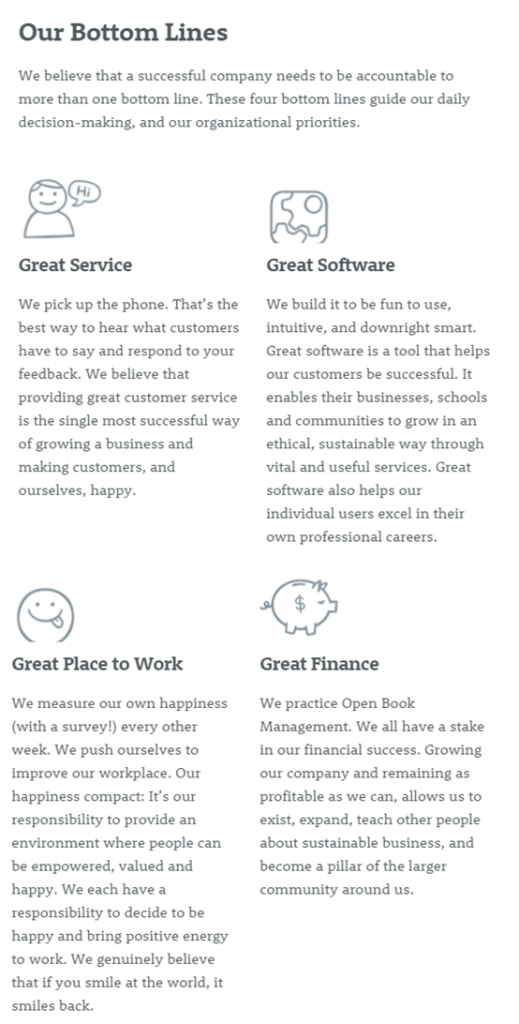The SaaS company’s distinctive approach fosters teamwork and high performance
Boulder’s SurveyGizmo displays its most important metrics for all to see and uses a collaborative weekly review process to engage all employees in performance improvement. Their methods place them at the forefront of management excellence in the young Software-as-a-Service industry, applying techniques reminiscent of those used by the world’s elite organizations.
Independent streak
 On the surface, SurveyGizmo seems like other SaaS companies. There’s the hip twenty-something workforce, foosball table and stocked fridge, along with inspiring values listed on their website. But unlike most SaaS companies, SurveyGizmo is entirely bootstrapped, relying on founder’s capital to get underway and funding their growth through free cash flow alone. It hasn’t stunted progress. In 2011, the survey technology company was ranked the 13th fastest growing software firm in the United States by Inc. Magazine and 144th fastest growing overall,[1] and today it serves over 12,000 customers. The company sets its own path. If CEO Christian Vanek adds a perk to enrich his employees’ experience, he doesn’t worry about being second-guessed by outside investors.
On the surface, SurveyGizmo seems like other SaaS companies. There’s the hip twenty-something workforce, foosball table and stocked fridge, along with inspiring values listed on their website. But unlike most SaaS companies, SurveyGizmo is entirely bootstrapped, relying on founder’s capital to get underway and funding their growth through free cash flow alone. It hasn’t stunted progress. In 2011, the survey technology company was ranked the 13th fastest growing software firm in the United States by Inc. Magazine and 144th fastest growing overall,[1] and today it serves over 12,000 customers. The company sets its own path. If CEO Christian Vanek adds a perk to enrich his employees’ experience, he doesn’t worry about being second-guessed by outside investors.
Open Books
 If independence characterizes SurveyGizmo’s philosophy on outside investment, interdependence describes its leadership style. The founders believe teamwork comes from high trust, enabled by high transparency.
If independence characterizes SurveyGizmo’s philosophy on outside investment, interdependence describes its leadership style. The founders believe teamwork comes from high trust, enabled by high transparency.
Managers post a giant grid listing essential metrics conspicuously in an open area. Twelve numbers trace directly to four core values (Great Finance, Great Service, Great Software, and Great Place to Work) and measures include weekly revenue, free trial conversion rates, percentage of customers self-served, and inbound call waiting times. With a glance, teams always know where they stand. Managers, employees and visitors alike can see weekly status and progress, or lack thereof. The message is clear—there’s nothing to hide and we’re all in this together.
 SurveyGizmo’s unique “Open Book” practice is then matched with exceptional employee participation. Each week the company conducts an “all hands” meeting to digest the trends and talk about the future. Individual contributors (not managers) from customer care, development, marketing and HR teams present the metrics and comment on deviations. Then the entire company breaks into small discussion groups to brainstorm ideas to improve performance. Discussions are then presented and synthesized, leading to action items and improvement projects. A facilitator ensures reviews stay on track and meetings wrap in one hour.
SurveyGizmo’s unique “Open Book” practice is then matched with exceptional employee participation. Each week the company conducts an “all hands” meeting to digest the trends and talk about the future. Individual contributors (not managers) from customer care, development, marketing and HR teams present the metrics and comment on deviations. Then the entire company breaks into small discussion groups to brainstorm ideas to improve performance. Discussions are then presented and synthesized, leading to action items and improvement projects. A facilitator ensures reviews stay on track and meetings wrap in one hour.
SaaS companies commonly use metrics to drive their operations, but few engage their whole workforce to review and improve performance. Rather than simply extol values, SurveyGizmo practices what it preaches by keeping everyone current. They also create a unique opportunity for all to contribute to the company’s success.
Roots in performance excellence
SurveyGizmo credits Zingerman’s for the idea. Started in 1982 as a local deli, Zingerman’s has expanded into a $45M baking, coffee, candy, mail order and training business. Inc. Magazine designated them “Coolest Small Company in America” and they’ve been featured in the Harvard Business Review. Zingerman’s core tenant is Open Book financials, in which all employees must know and speak accounting language to better understand and grow the business. Zingerman’s ZingTrain division educates hundreds of companies on their special practices every year.
But as it is with popular management approaches, origins date back further than most realize. Dr. Kaoru Ishikawa, a protégé of quality guru W. Edwards Deming, is credited with introducing the first “quality circles” at Nippon Wireless and Telegraph Company in 1962.[2] A quality circle is a team of workers who do the same or similar work, meeting regularly to identify, analyze and solve work-related problems.[3] Mieruka (visual control) was another early Japanese innovation. Managers implemented common visual signals, rather than written instructions, to communicate process information clearly and efficiently. Nichijo kanri (daily control) soon followed, a technique using color-coded metrics to communicate status of key processes across the organization.[4] Robert Kaplan and David Norton later expanded on the idea in their bestseller The Balanced Scorecard, espousing a mix of financial and nonfinancial measures to track progress meeting strategic goals.[5]
Today, top-performing organizations use enterprise-wide metrics systems and conduct multi-level reviews to interpret and act on them. The Baldrige Performance Excellence Program, celebrating leadership in business, education, health care, government and non-profits, evaluates award applicants on how well they set, track, review and improve essential metrics throughout in the organization.[6] In addition to Boeing, Ritz-Carlton and Cargill, Colorado’s own Elevations Credit Union, Poudre Valley Health System and CH2M Hill OMI gained national recognition as Baldrige Award recipients. Studies show companies using strategic management systems like Baldrige outperform rivals by a factor of 2:1 over the long term.[7]
Leading their nascent industry
Perhaps because of their independent streak, SurveyGizmo has become among the first SaaS companies to both define metrics and systematically engage their entire workforce in improving them. They defy conventional wisdom by making their results extraordinarily transparent. And they enact their values companywide through a simple but powerful review process. Their Open Book practice sets them on a path to compete with anyone on the world’s stage, making them a company to watch in the years ahead.
Did you enjoy this article? Subscribe to Excel-lens now and never miss another post.
Sources:
[1] Top Software Companies on the 2011 Inc. 5000. Inc. Magazine, May 2011.
[2] Ishikawa, K. (1980) [original Japanese ed. 1970]. QC Circle Koryo : General Principles of the QC Circle. Tokyo: QC Circle Headquarters, Union of Japanese Scientists and Engineers.
[3] Inc. Encyclopedia – “Quality Circles”
[4] Soin, S. (1998) Total Quality Essentials. McGraw-Hill Professional; 2 edition. ISBN-13: 978-0070595514
[5] Kaplan, R. and Norton, D. (1996) The Balanced Scorecard: Translating Strategy into Action. Harvard Business School Press, ISBN 0-87584-651-3
[6] 2015-2016 Baldrige Excellence Framework, Baldrige Performance Excellence Program
[7] Hendricks, K. and Singhal, V. (2000) The Impact of Total Quality Management (TQM) on Financial Performance: Evidence from Quality Award Winners. DuPree College of Management, Georgia Institute of Technology.
